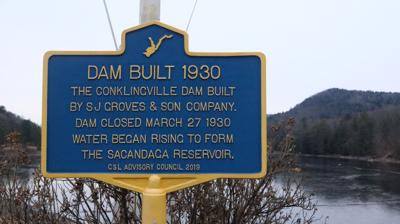CONKLINGVILLE — One vote a century ago directly led to the end of the Sacandaga River Valley.
From Albany, members of the then-Hudson River Regulating District board on May 7, 1924 unanimously voted to build the Conklingville Dam in Hadley, which would deluge seven rural towns in Fulton and Saratoga counties with billions of cubic feet of water six years later.
Creating the Great Sacandaga Lake was intended to protect densely populated downstream communities from devastating seasonal floodwaters. The trade-off: through eminent domain, hundreds of residents were forced to leave their communities.
“It is difficult to imagine the project in 2024,” said John Callaghan, executive director of Hudson River-Black River Regulating District.
Callaghan, who has led HRBRRD since 2019, said the review process for a sizable proposal would likely face far more red tape and resistance in the modern era.
Pressure was on the state in the late 1800s and early 1900s to prevent spring flooding in areas such as Troy, Watervliet, Waterford and Glen Falls. Lawmakers finally sprung to action after floodwaters in 1913 contaminated Albany’s water supply, resulting in a typhoid epidemic.
A 1915 law allowed for the creation of reservoirs in forest preserves for flood mitigation purposes. This opened the door for the creation of two respective regulating districts in 1918 and 1922.
“When they make this decision, the state is deciding that they're going to flood out the rural people so that they don't flood out the urban people downstream where the industry is stronger and population is denser,” said Saratoga County Historian Lauren Roberts. “That's a pretty common thing to see when you're talking about projects that are for the public good.”
The Sacandaga Valley was home to Native Americans for thousands of years before it was settled by Europeans in the 1700s under an eponymous land grant. Throughout the 1800s, it became home to a bevy of farmers, loggers and tanners.
The local industry peaked around the 1870s and 1880s. Once it started to wane, it never fully bounced back. Roberts said that the area’s struggling economy and dwindling population supported officials’ rationale behind flooding the valley.
Edinburg Supervisor Jean Raymond said some negative sentiments from the takeover and subsequent flooding of the land in 1930 have persisted.
“I know that there is certainly some bitterness amongst people that were impacted through heredity,” Raymond said. “Their land was taken away and their way of life changed, but the area was not. It wasn't doing extremely well financially to begin with.”
In preparation for the flooding, homes were torched or moved, trees were cleared and graves were relocated beyond the so-called taking line — the boundary in which properties were kept undisturbed.
Portions of Edinburg, Northampton, Mayfield, Broadalbin, Day, Hadley, and a smidge of Providence — including more than a dozen hamlets — are currently underwater. Still submerged are two bridges, building foundations and tree stumps.
“If the water is really, really low, there are places where you can see the stumps of what was cut down and where the road used to go around the river,” Raymond said.
Lake levels fluctuate throughout the year based on snowmelt and rain. The 29-mile reservoir can hold up to 37.75 billion cubic feet of water at a time.
The engineering behind the dam remains mostly unchanged nearly a century later, according to Callaghan. Over time, he expects that the dam will become more active as a result of climate change.
“I think that that mission is the same, the function of the reservoir is the same, but maybe the need for this type of reservoir is even greater than it was 100 years ago,” said Callaghan.
Scheduled to commence in 2025 is a $60 million dam rehabilitation project. Among improvements, crews are expected to remove deteriorated concrete and replace outlet valves.
Images: Great Sacandaga Lake in recent years (16 photos)

PETER R. BARBER The Bacheller Bridge can be seen in the distance over Great Sacandaga Lake in Northampton Thursday, March 7, 2024.

The Great Sacandaga Lake on Feb. 29, 2024.

A sign for the Conklingville Dam, where the Sacandaga River meets the Great Sacandaga Lake, in Hadley, Friday, Dec. 23, 2023.

The Conklingville Dam, where the Sacandaga River meets the Great Sacandaga Lake, in Hadley, Friday, Dec. 23, 2023.

The right arm of the Great Sacandaga Lake near the Conklingville Dam in Hadley on Friday, Dec. 23, 2023.

Beacon Island on the Great Sacandaga Lake, Wednesday, Sept. 20.

A watershed map of the Great Sacandaga Lake on Lakeside Drive in Mayfield, Wednesday, Sept. 20.

Russell Cecil, of Fort Johnson, pilots the ‘Mickey Lee’ onto a partially-submerged boat trailer as Tony Lapi, of Sprakers, awaits at the Broadalbin Boat Launch Sunday, after taking part in a bass fishing tournament.
Nice and easy

Rotterdam resident Nick Baum brings his jet ski closer to the beach adjacent to the Broadalbin Boat Launch on the Great Sacandaga Lake Wednesday.

A Mallard comes in for a landing on Great Sacandaga Lake Wednesday

Beacon Island as viewed from Driftwood Park in Gloversville at the Great Sacandaga Lake Wednesday, July 27.

DEC Boat Steward Jordan Iannotti of Glenville inspects a jet ski for invasive species before it enters the Great Sacandaga Lake at the boat inspection station at the Broadalbin Boat Launch in Broadalbin on Sunday, July 3, 2022.

Nate Fuelleman of Fultonville holds up a buzzer beater 43-inch pike he caught and released on the last day of the season while fishing the Great Sacandaga Lake. (Photo provided)

PETER R. BARBER/THE LEADER-HERALDLisa Sorvello cheers as she breaks the surface of the Great Sacandaga Lake near Wally’s Driftwood Park in Mayfield as she and a host of other brave souls did a Polar Bear Plunge on Saturday.

ERICA MILLER/THE DAILY GAZETTEFrom left, Emma Maloney-Diamond of Broadalbin, Blayke Bailey, 4, of Johnstown, and Yanisha Maloney-Diamond, 6, of Schenectady, begin the construction of a sand castle at Broadalbin Boat Launch on Great Sacandaga Lake on Aug. 24, 2021.

Folks pull into the docks at Lanzi’s On The Lake at the Great Sacandaga Lake.
























